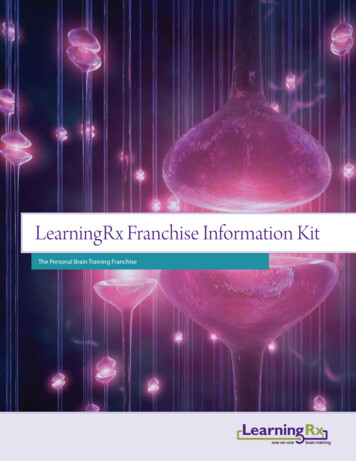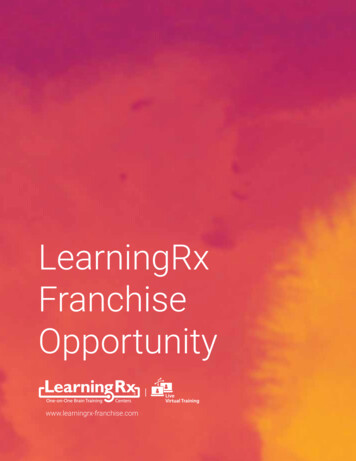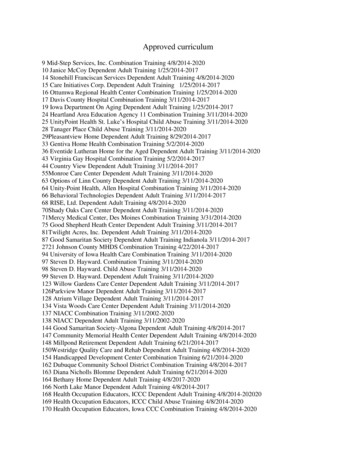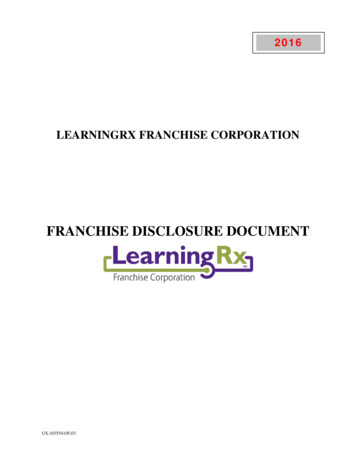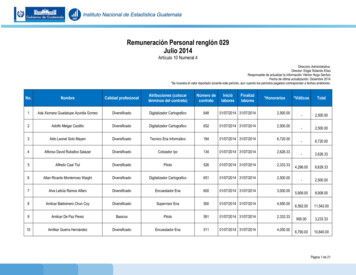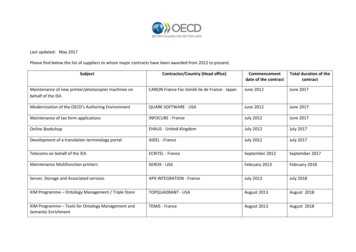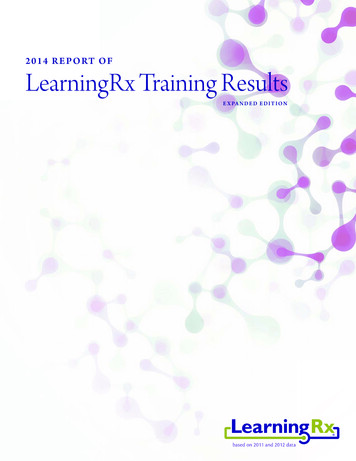
Transcription
2 0 1 4 R e p o Rt o fLearningRx Training Resultse x pa n d e d e d i t i o nbased on 2011 and 2012 data
Table of Contents2 Introduction from Dr. Ken Gibson3 About the Statistics in This Report4 Who Benefited from LearningRx in 2011–20126 Step One: Finding the Cause7 Step tWO: Addressing the problem8 Step thRee: Measuring the Results of LearningRx Brain training89101112Measuring Results by Cognitive Skills percentile GainsMeasuring Results by elimination of performance GapMeasuring Results by Gains in IQThe Difference Between percentiles and percentageshow Brain training helps Those with Specific Diagnoses:121214141415Attention Deficit hyperactivity Disorder (ADhD)Reading problems and DyslexiaLearning DisabilitiesSpeech and Language DisordersAutism Spectrum Disorderstraumatic Brain Injury (tBI)16 Step FOuR: Measuring the Value of LearningRx Brain training16161819Measuring Value Based on SatisfactionMeasuring Value by Retention of GainsMeasuring Value Based on CostMeasuring Value Based on Return on Investment20 Conclusion22 Statistical AnalysisWhereas other programs will not guarantee gains for individuals participating in their programs, LearningRx will.Individual results, however, can vary from the averages presented in this report and from student to student.
Introduction from Dr. Ken GibsonOver 6,000 children and adults receivedtraining in 2011 and 2012 at 80 LearningRxBrain training Centers throughout the unitedStates. Some were college students seekinggreater academic success. Others were careeror senior adults wanting to stay mentallysharp, or accident victims wanting to regainskills they had lost due to an injury.Dr. Ken Gibson is thefounder and CEO ofLearningRx, a companywith over 85 centers acrossthe country specializingin making kids and adultsof all ages measurablysmarter through researchbased programs that trainthe brain.The majority, however, were studentsstruggling to do better in school.Why did their families choose one-on-onebrain training over tutoring? perhaps it'sbecause, dollar for dollar, one-on-one braintraining is more than 10 times more effectivethan tutoring. (Want dollar figures? Seepage 19.)here's why personalized, one-on-one braintraining is so effective:tutoring reteaches information that wasn’tgrasped the first time around. LearningRxtakes a different approach, strengtheningthe underlying brain skills that improve howstudents grasp and learn information thefirst time it is presented! And since studiesshow that about 80% of all learning struggles1are the result of weak cognitive skills, bystrengthening those skills, LearningRx braintraining gets to the root of most learningstruggles. For a student who has struggled foryears, you can’t imagine how life changingthis can be!Furthermore, LearningRx brain training isresearch-based. We are constantly evaluatingour results, and applying the latest research tomodify and improve our programs.not only that, but at LearningRx we measurethe gains of every student using the goldstandard of cognitive skills testing. This meansthat LearningRx not only gets unmatchedresults, we can measure those resultsscientifically.In the following report, you'll see some ofthe impressive results of our personalized,one-on-one brain training programs. (Like 3.1years of reading gains in as little as six months.See page 12.)What you can't see in these pages are thelifelong benefits our students and clientsof all ages enjoy as a result of brain training.LearningRx clients don't just get better gradesand greater IQ; they get faster, sharper brainsthat help them succeed in every area of lifeover the course of their entire life. (Did youknow that LearningRx brain training raises IQby an average of 15 points,2 which statisticslink to higher salaries? In fact, statistics provethat even a 10-point increase in IQ can resultin as much as 20,000 more in earnings peryear! See page 19.)By the way, I’m pleased to tell you that ourdata has undergone detailed statisticalanalysis that supports the statisticalsignificance of these results. I would alsolike to take this opportunity to invite otherresearchers to evaluate our training withtheir own independent studies. We are verytransparent about our training results andwould be happy to work with you.The results are in. LearningRx brain trainingchanges lives. Will it change yours, or that ofsomeone you love?Dr. Ken GibsonFounder & CeO, LearningRx1 To learn more about the 80% figure, see page 21.2 LearningRx brain training raises IQ by an average of 15 points among students who do all of their training inone of our centers, and by an average of 14 points across the board, including clients who did some of theirtraining at home.2
About the Statistics in This ReportWhat does it mean for a result to be “statistically significant”?Sometimes things happen by chance. Sometimes the relationship between two events is suchthat it’s hard to say what really caused the change in question. Did one thing cause the other,or is coincidence at play?Measuring the likelihood that an event occurred by chance is the idea behind “statisticalsignificance.” If you are a professional (or parent) interested in the statistical significance of theresults represented in these pages, you’ll want to check out the statistical analysis conductedon our data by Dr. Kirk Cameron, and summarized by Amy Moore, M.A.Dr. Kirk CameronDr. Cameron is the founder and president of MacStat Consulting, Ltd., a statistical consultingfirm in Colorado Springs, Colorado. he has has more than 20 years’ experience teaching andconsulting to private firms and government entities including the uSepA, and the uS Air Force.Ms. Moore has a Masters in education, and is a college instructor and doctoral candidate ineducational psychology with an emphasis on quantitative research.You can find Ms. Moore’s summary in the section on statistical analysis beginning onpage 22 of this report. to review Dr. Cameron’s complete analysis, visit the website:www.learningrx.com/resultsAmy L. Moore, M.A.3
Who Benefited from LearningRx in 2011–2012?In 2011 and 2012, over 6,000 children, teens, andadults received training at more than 80 LearningRxBrain training Centers across the country. Theycame to LearningRx from every age and stage of life,all of them seeking the life changing benefits of afaster, smarter brain.The majority of our clients were school-agedchildren and teens struggling to succeed in school—particularly students with reading and attentiondifficulties. According to the national Report Card,only 37% of fourth and eighth graders in the unitedStates are proficient in reading and math. (That’sfewer than four out of ten students!) LearningRxbrain training helps these students because ourprograms strengthen the weak cognitive skills thatstudies say are at the root of 80% of all learningstruggles.The Nation’s Report CardUS Scores for Reading and Math in 20134th graders testing as lessthan proficient in readingand math:8th graders testing as lessthan proficient in readingand math:ReadingMathReading65%58%64%Math65%To learn more about the Nation’s Report Card, visit:http://www.nationsreportcard.govIn addition, clients of all ages came to us reportingvarious issues or diagnoses as reported below.Percentage of Clients Who Came to LearningRxReporting the Following Symptoms:Attention issuesReading strugglesPoor comprehensionWorking slowlyLow math skillsWriting strugglesPoor spellingAvoiding schoolworkPoor memoryMotivation/behavior issuesLow self-esteemLoses place/skips wordsReverses lettersOtherOverly activeWorks too 1%Percentage of Clients Who Came to LearningRx Having BeenPreviously Diagnosed Within One of the Following Categories:TraumaticBrain Injury1%Gifted None8%Autism ageDisorder10%Learning Disability11%NOTE: LearningRx does not diagnose clients or remove diagnoses. The diagnoses listed in this report are reported by clients, and we are onlydesignating this information based on what clients have told us. All individuals should consult with a medical professional for all mattersrelated to a specific diagnosis.4
“I am able to pay attention and stay focused Thank you!”“Before coming to LearningRx, I was having a difficult timeconcentrating and staying focused on tasks. Just a couple weeksafter starting my training, I saw improvements in my daily activities.I am able now to remember things I need to do or grocery lists. Themost significant improvement is in my attention. Before braintraining, I had a hard time paying attention in class and readingrequired materials. Now I am able to read and actually comprehendwhat I read the first time. I am also able to sit through a three-hourclass and pay attention and stay focused the entire time. Thank youso much!”— Amanda in Los AngelesFinally, the following charts show the distribution of clients who received training at our centers in 2011 and 2012 accordingto age and gender:Ages of LearningRx Clients in 2011 and 2012Gender of LearningRx Clients in 2011 and 2012Average age: 12.3 yearsAge 30 : 4%Age 20–24: 3%Younger than age 6: 3%Age 17–19: 4%Age 16: 4%Age 6:5%Age 7:9%Age 15: 5%Age 8:11%Age 14: 5%Age 13:7%Age 11:6%Age 10:6%Female40%Male60 %Age 9:11%Age 12:8%Age 11:9%Age 10:10%In summary, the average age of our clients was 12.3 years, with the majority of our clients between the ages of eight andthirteen. Male students outnumbered female clients 60 to 40 percent.5
Step One:Finding the Causepeople come to us for help because they want to readbetter, learn faster, increase attention skills, develop a sharpermemory, or simply process information more quickly. Butbefore we can address any of these issues, we need to knowwhich underlying cognitive skills are weak and causing theproblem.tests we use:LearningRx uses the gold standard of assessment tools,including the Woodcock-Johnson tests of Cognitive Abilitiesand the Woodcock-Johnson tests of Achievement. Thesenationally standardized tests are used across the country byeducators and psychologists to measure cognitive skills andacademic abilities.The Woodcock-Johnson tests also generate a GeneralIntellectual Ability (GIA) score, which represents the gfactor (often referred to as general intelligence or IQ). Wewill commonly refer to the GIA score as IQ throughout thisreport.These tests, along with learning skills rating scales, allow usto identify any weak skills that are making life harder than itneeds to be.sKILLs we stReNGtHeN:There are eight categories of cognitive skills that, whenweak, contribute to struggles with thinking, reading,learning, memory, and attention. Our programs target andstrengthen these skills. The cognitive skills that our programsimprove include the following:Long-term Memory: The ability to recall informationthat was stored in the past.processing Speed: The ability to perform simple orcomplex cognitive tasks.Logic & Reasoning: The ability to reason, form concepts,and solve problems using unfamiliar information or newprocedures.Short-term Memory: The ability to apprehend andhold information in immediate awareness whilesimultaneously performing a mental operation.6Visual processing: The ability to perceive, analyze, andthink in visual images.Auditory processing (phonemic awareness): The abilityto analyze, blend, and segment sounds.Attention (three types): Sustained attention is theability to stay on task for an extended period of time;selective attention is the ability to stay focused and notget distracted; divided attention is the ability to handlemore than one task at a time.Word Attack: The ability to apply phonic and structuralanalysis skills to pronounce unfamiliar printed words.About ouR scoRes:As you look at the information in this report, you’ll see thattest scores are commonly presented in three forms:Age equivalent Scores may be applicable up to the age of16 and indicate how one student’s scores compare withthe average scores of other age groups.percentile Scores indicate where a student would rankin a hypothetical group of 100 students. (For example: Ifa student ranked in the 25th percentile, it would meanthat he scored as well or better than 25% of students inthe group. If a student ranked in the 87th percentile, itwould mean that he scored as well as or better than 87%of students in the group.) Why do we report our gainsin percentiles rather than percentages? percentages don’ttell the whole story. A student who starts out performingin the 5th percentile and jumps to the 15th hasexperienced a 200% gain. That sounds really impressive,but that student is still performing behind 85% of hisor her peers. When gains are measured in percentiles,however, you can see what has been accomplished,get a clear picture of how that student is performing inrelationship to his peers, and make informed decisionsabout what interventions may still be needed. (to learnmore about the difference between percentiles andpercentages, see page 11.)Standard Scores indicate how far above or below averagean individual score falls, using a common scale (ex:“average” of 100). IQ is normally presented as a standardscore with “100” being average.
Step Two:Addressing the ProblemOnce we identify which cognitive skills are weak, our trainersprovide intense one-on-one training designed to target andstrengthen those skills. here are our six core programs:ThinkRx is a fully integrated system of cognitive training exercisesdelivered in an intense, one-on-one environment. ThinkRx quicklyidentifies and corrects weak skills including: attention, short-termand long-term memory, processing speed, logic & reasoning, andvisual and auditory processing.ReadRx is a revolutionary ‘sound-to-code’ accelerated readingprogram modeled after the process by which spoken language isfirst learned. ReadRx includes the ThinkRx program.ComprehendRx targets the brain skills critical for readingcomprehension. Going far beyond decoding written words, thisprogram strengthens the skills necessary for dramatically improvedunderstanding, retention, and application. ComprehendRxincludes ThinkRx and ReadRx.MathRx is a unique program that tests, trains, and strengthensthe core mental skills necessary for overall math success, criticalthinking, and problem solving. MathRx includes ThinkRx.einstein combines our ThinkRx, ReadRx, and MathRx trainingprograms, and can include ComprehendRx as well.LiftOff is a school-readiness program designed for preschool,kindergarten, and first grade students. Brain training builds astrong foundation of brain skills for long-term academic success.In 2011–2012, more than 77% of our clients participated in eitherThinkRx or ReadRx programs, with the average length of trainingrunning about 18 weeks.parents of school-aged children can choose how involved theywant to be in their child's training. parental involvement can rangefrom very little to providing about 80% of the training.Almost half of parents (48%) selected our “pro program,” wherethe full five to six hours of weekly training is done by the centerstaff. Forty-eight percent opted for our “partner program” whichallows parents to provide about half the training at home. Fourpercent of parents went with the “Directed program,” in whichthey provided the majority of training at home, with one hourprovided weekly by the center staff.Percentage of Students by ProgramProgramPercentageProgram LengthThinkRx42%12 weeksReadRx135%24 weeksComprehendRx2n/an/aMathRx18%20–24 weeksEinstein38%32 weeksLiftOff7%12 weeks1 Includes ThinkRx2 This data is not yet available for ComprehendRx,which was launched in 20143 Includes ThinkRx, ReadRx, and MathRx“Erica’sconcentration hasimproved as well asher confidence ineverything shedoes. She has beenmore willing to try new activities sincegoing through the LearningRx program.Her overall improvement in all of herclasses was very exciting to see. Theimprovement was reflected in her highergrades and not having to struggle withhomework.”— Lorraine from NebraskaPercentage of Parental ParticipationParent Participation Per WeekPercentage5 hours (via the Directed Program)4%3 hours (via the Partner Program)48%0 hours (via the Pro Program)48%7
Step Three: Measuring the Results ofLearningRx Brain TrainingResuLt: stRoNGeR coGNItIve sKILLsThe following graphs show before- and after-training results for more than 6,000 clients who underwent an average of 18weeks (90 hours) of training. For simplification purposes, all the scores you’ll see in this report have been rounded up ordown to the nearest whole number.The graphs show changes in percentile rank. As mentioned, percentile rank indicates where someone would rank in a groupof 100 of their peers, with 50 being average. In other words, if 100 students lined up accordingto how well they performed on a test, a student in the 25th percentile, for example, would beTo learn moreabout the statisticalnumber 25 from the bottom end of the line, having scored equal to or better than 25% (and notsignificance of theseas well as 75%) of the other students.results, see thesection on statisticalanalysis on page 22.The following chart shows improvements in clients with severe cognitive weaknesses who initiallytested in the lowest percentile (25th percentile or lower). After brain training, these clients“moved up in line” an average of 29 percentile points:Percentile Improvements Among LearningRx Clients with Severe Cognitive Weakness124312Logic & Reasoning45Auditory Processing12401542Visual ProcessingShort-Term Memory1449Processing Speed1131Long-Term MemoryBefore LearningRxBrain TrainingAfter LearningRxBrain TrainingBefore LearningRxBrain TrainingAfter LearningRxBrain TrainingThis chart shows improvements in clients with moderate cognitive weakness who initially tested between the 26th and50th percentile. After brain training, these clients “moved up in line” an average of 27 percentile points:Percentile Improvements Among LearningRx Clients with Moderate Cognitive Weakness3867Logic & Reasoning71Auditory Processing38593962Visual ProcessingShort-Term Memory3866Processing Speed3766Long-Term MemoryBefore LearningRxBrain Training838After LearningRxBrain TrainingBefore LearningRxBrain TrainingAfter LearningRxBrain Training
Finally, this chart shows improvements in clients with above-average cognitive skills who initially tested in the 51st to 75thpercentile. These clients “moved up in line” an average of about 14 percentile points:Percentile Improvements Among LearningRx Clients with Above-Average Cognitive Skills638063Logic & Reasoning82Auditory Processing62707079Visual ProcessingShort-Term Memory627971Processing Speed83Long-Term MemoryBefore LearningRxBrain TrainingAfter LearningRxBrain TrainingBefore LearningRxBrain TrainingAfter LearningRxBrain TrainingResuLt: NARRowING tHe PeRfoRmANce GAPAnother way to measure the overall results of LearningRx brain training is to consider the gap between how well someoneperformed in cognitive function prior to brain training, and the highest possible performance.Our goal is to eliminate 35% or more of that gap by the time each client completes the recommended LearningRx trainingprogram (an average of 18 weeks of training). And if the same client participates in follow-up training a year later, our goalwould be to eliminate 35% or more of the remaining gap, and so on.The following chart shows, on average, how much of the gap was eliminated in 2011 and 2012 based on how big the gapwas to begin with:Narrowing the Performance GapHighest Possible 100Percentile807564% ofgap9176Gap4556% ofgap60Post-Training Scores4540Post-Training GapPercent Eliminated204235% ofgap1515Pre-Training Scores09
ResuLt: HIGHeR IQYet another way to measure the improvements made byLearningRx clients is by tracking gains in overall IQ (referredto as General Intellectual Ability [GIA] in the WoodcockJohnson assessment results). 15After LearningRx brain training, clients experience an averageincrease in IQ of 15 points.1 This is based on the experiencesof 3,230 LearningRx clients (all the clients for whom we haveGIA scores).In addition, gains in IQ are achieved across all age groups. Asseen in the chart below, LearningRx clients from four yearsold to 80 experienced significant gains in IQ:Average Gain in IQ Points Among ClientsWith All Levels of Cognitive Weaknesses1Average Gain in IQ Based on Age of Client125 3110 12 1610098.333340121 16 9 14 11113 15106 16104111.666679 14 14 15 14 14 15104 13 14 12108115112The bell curve provides anotherway to look at the gains thatLearningRx clients make in IQ.60 10750‒59 10140‒49 9730‒39 9320‒29 9018‒19 9216 9715 9614 9813 9712 9517 95After Brain TrainingBefore Brain Training35302520 55%1017%153%The purple bars show how thesesame clients tested in IQ afterone-on-one brain training. Youcan see that more clients score inthe higher IQ ranges after braintraining, with 56% scoring 110 ormore in IQ.Percentages of LearningRx Clients Arranged byIQ Scores Before and After One-on-One Brain Training9%In the chart to the right, the greenbars show the distribution of IQscores of incoming LearningRxclients (before brain training). Asyou can see, 32% of our clientscome to us with IQ scores inthe 90-99 range, with just 18%scoring 110 or more in IQ.11 9710 989 976 9985.00000085 6 99908 969591.6666707 100IQ AfterBrainTraining120118.333349Standard ScoreIQ BeforeBrainTraining 14 120IQ Range1 LearningRx brain training raises IQ by an average of 15 points among students who do all of their training in one of our centers, and by anaverage of 14 points across the board, including clients who did some of their training at home.10
22Average Gain in IQPoints Among ClientsWith Severe CognitiveWeaknessesIQ Scores of LearningRx Clients with Severe Cognitive WeaknessBefore and After Brain TrainingIQ Scores Before Brain TrainingIQ Scores After Brain TrainingGIA (Standard Score)Finally, based on average IQ scores,this chart shows the gains ourstudents experienced in terms of IQ.For example, before brain training,students who had severe cognitiveweaknesses had IQ scores, onaverage, of 81. After brain training,these same students had IQ scores,on average, of 103. That’s a gain of22 IQ points!103105999387817581Severe Cognitive WeaknessWhat Is the Difference Between Percentile Points and Percentages?What would a percentile point increase look like if it were described in terms of percentages? You might be surprised. A large jumpin percentile ranking converts to an even larger percentage of improvements in skills. See these examples below:Converting Percentiles into Percentages:Moving from the 5th to the 15th percentile represents a skills gain of 200%Moving from the 10th to the 20th percentile represents a skills gain of 100%Moving from the 50th to the 60th percentile represents a skills gain of 20%Here’s another way of seeing the difference.LearningRx ImprovementsShown in Percentile PointsLearningRx ImprovementsShown in PercentagesAnother Company’s ImprovementsShown in PercentagesImprovements after brain training amongstudents with moderate cognitive weaknessImprovements after brain training amongstudents with moderate cognitive weaknessAs reported by a national companyamong students who completed theirtutoring program100CONV E dShort-TermMemoryLogic e LearningRx Brain TrainingCOMP A R E63%58%6085%84%20Logic e100After LearningRx Brain Training042.7%23.7%MathReadingAfter TutoringAfter LearningRx Brain TrainingIn the chart above, you can see theaverage gains experienced by ourstudents with moderate cognitiveweaknesses, as represented inpercentile points.This chart shows what those exactsame gains look like in terms ofpercentage of skills gained.By the way, when we say LearningRxbrain training is more effectivethan tutoring, we mean it! Thischart shows the percentage of skillsgained as reported by a nationwidetutoring company! Compare theirpercentages to ours!11
How bRAIN tRAINING HeLPs sPecIfIc DIAGNosesLearningRx does not assign diagnostic labels. Our clients,however, often report having received a diagnosis prior tocoming to LearningRx. In the following pages, you will findstatistics as they relate to specific diagnoses.How brain training Helps clients with ADHDThe most common diagnosis with which clients come toLearningRx is Attention Deficit hyperactivity Disorder(referred to here as ADhD).ADhD begins in childhood, with many children with ADhDcontinuing to struggle into adolescence and adulthood.Dyslexia is a learning disability that hinders a person’sability to read, write, spell, and sometimes speak. The mostcommon learning disability in children, dyslexia can persistinto adulthood, although the sooner dyslexia is addressed,the more favorable the outcome.During 2011 and 2012, 2,604 clients were enrolled in theReadRx training program. After less than six months inthe program, these clients gained between 2.7 to 3.7years in age-equivalent reading skills. The average readingimprovement was 3.1 years in less than six months. Readingimprovement is measured with the word attack test. Wordattack is the ability to apply phonic and structural analysisskills to pronounce unfamiliar printed words.LearningRx offers hope and help to children and adults withADhD. That’s because the exercises in our program target theunderlying cognitive skills—including sustained attention,divided attention, selective attention, and processingspeed—that strengthen attentionskills.To learn moreabout the statisticalsignificance of theseresults, see thesection on statisticalanalysis on page 22.The following chart shows overallpost-training gains made byclients who came to us with aprior diagnosis of ADhD andwho tested at or below the 50thpercentile. On average, these clients moved up between 25and 33 percentile points, which represents a 3.1 to 5.7 yeargain.What’s significant is that these gains were consistentregardless of where a student initially ranked in reading.Students who tested significantly behind their peers—andstudents who tested at average or even above average—stillexperienced gains in reading skills.Average Age-Equivalent Gains in Reading After BrainTraining by Severity of Reading ProblemPercentile GainGeneral Intellectual Ability (GIA)Logic & ReasoningProcessing SpeedAuditory ProcessingLong-Term MemoryShort-Term MemoryVisual Processing31303133322625How brain training Helps clientswith Reading Problems and DyslexiaReading, perhaps more than any other academic challenge,depends on strong cognitive skills for consistent success.efficient auditory processing is at the core of all readingsuccess. Studies by the Department of education havesuggested that poor auditory processing skills contribute toover 88% of the nation’s reading problems!LearningRx testing quickly identifies specific auditoryprocessing deficits. Of all the improvements that LearningRxbrain training consistently produces, the improvements inreading skills are among the most dramatic and life changing.12 3.1 years4.03.5Age-EquivalenceSkill TestedAverage Gain in Reading After Six Monthsfor All ReadRx Students3.7 yeargain3.03.4 yeargain2.5 2.7 yeargain2.02.5 eAverageSeverity of Reading ProblemAnother interesting trend we see is that the older studentsare at the point when they come to us for help, the fartherbehind their peers they tend to have fallen. In 2011 and2012, for example, our average 10-year-old student initiallytested at 12 months behind in age-equivalent scores, our
average 13-year-old student initially tested 2.3 years behind, and our average 16-year-old student initially tested 3.5 yearsbehind. The good news is that these students typically see a larger improvement in reading skills than younger studentswho have less catching up to do.Average Age-Equivalent Gains in Reading Before and After ReadRx (by Age) 5.918Age-EquivalentScore AfterReadRx16Age EquivalenceAge-EquivalentScore BeforeReadRx14121086 5.5 4.2 4.9 18.5 17.9 4.5 4.617.5 4.116.2 16.416.2 3.7 3.714.814.0 2.5 13.513.312.6 12.4 1.911.7 11.811.511.3 1.7 1.810.710.4 1.610.39.89.1 9.69.08.38.57.4 7.86.74 6 78910 11 12 13 14 15 16 17 18 1920 81Age“We couldn’t picture a life for our daughter in whichshe couldn’t read. Now, we don’t have to.”“Our daughter’s struggles began in kindergarten. By thirdgrade, testing revealed that she suffered from dyslexia.Simply having a diagnosis, however, didn’t help. In spite oftutoring, her frustration with reading increasingly erodedher self-esteem and kept her from participating in class.“This is where LearningRx entered our lives. The directortold us we could expect reading gains ranging from threeto five years. Both my wife and I are in education, and weknow things like this just don’t happen. We were wrong!Our daughter’s reading confidence increased. Choppinesssmoothed out. For the first time she began to sound like anatural reader.“Now, after three quarters in middle school, our daughter has gotten all A’s with only two B’s.We are absolutely thrilled and amazed. LearningRx results are undeniable. Would I recommend itto a parent with a struggling reader? Unequivocally yes! We couldn’t picture a life for our daughterin which she couldn’t read. Now we don’t have to. Thank you, LearningRx!”— Miles from California13
Skill TestedPercentile GainGeneral Intellectual Ability (GIA)Logic & ReasoningProcessing SpeedAuditory ProcessingLong-Term MemoryShort-Term MemoryVisual Processing24232426242021How brain training Helps clientswith speech and Language Disorders“I’m loving school so much more!”“School this year seems so much easie
LearningRx, a company with over 85 centers across the country specializing in making kids and adults of all ages measurably smarter through research-based programs that train the brain. 1 To learn more about the 80% figure, see page 21. 2 LearningRx brain training raises IQ by an average of 15 points among students who do all of their training in
